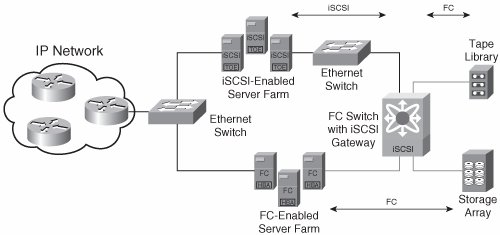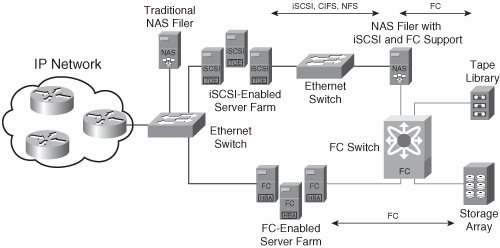iSCSI
| This section provides a brief introduction to the Internet Small Computer System Interface (iSCSI) protocol. iSCSI Functional OverviewAs indicated in Chapter 2, "The OSI Reference Model Versus Other Network Models," iSCSI is a Small Computer System Interface (SCSI) Transport Protocol. The Internet Engineering Task Force (IETF) began working on iSCSI in 2000 and subsequently published the first iSCSI standard in 2004. iSCSI facilitates block-level initiator-target communication over TCP/IP networks. In doing so, iSCSI completes the storage over IP model, which supported only file-level protocols (such as Network File System [NFS], Common Internet File System [CIFS], and File Transfer Protocol [FTP]) in the past. To preserve backward compatibility with existing IP network infrastructure components and to accelerate adoption, iSCSI is designed to work with the existing TCP/IP architecture. iSCSI requires no special modifications to TCP or IP. All underlying network technologies supported by IP can be incorporated as part of an iSCSI network, but most early deployments are expected to be based solely on Ethernet. Other lower-layer technologies eventually will be leveraged as iSCSI deployments expand in scope. iSCSI is also designed to work with the existing SCSI architecture, so no special modifications to SCSI are required for iSCSI adoption. This ensures compatibility with a broad portfolio of host operating systems and applications. iSCSI seamlessly fits into the traditional IP network model in which common network services are provided in utility style. Each of the IP network service protocols performs a single function very efficiently and is available for use by every "application" protocol. iSCSI is an application protocol that relies on IP network service protocols for name resolution (Domain Name System [DNS]), security (IPsec), flow control (TCP windowing), service location (Service Location Protocol [SLP], and Internet Storage Name Service [iSNS]), and so forth. This simplifies iSCSI implementation for product vendors by eliminating the need to develop a solution to each network service requirement. When the IETF first began developing the iSCSI protocol, concerns about the security of IP networks prompted the IETF to require IPsec support in every iSCSI product. This requirement was later deemed too burdensome considering the chip-level technology available at that time. So, the IETF made IPsec support optional in the final iSCSI standard (Request For Comments [RFC] 3720). IPsec is implemented at the OSI network layer and complements the authentication mechanisms implemented in iSCSI. If IPsec is used in an iSCSI deployment, it may be integrated into the iSCSI devices or provided via external devices (such as IP routers). The iSCSI standard stipulates which specific IPsec features must be supported if IPsec is integrated into the iSCSI devices. If IPsec is provided via external devices, the feature requirements are not specified. This allows shared external IPsec devices to be configured as needed to accommodate a wide variety of pass-through protocols. Most iSCSI deployments currently do not use IPsec. One of the primary design goals of iSCSI is to match the performance (subject to underlying bandwidth) and functionality of existing SCSI Transport Protocols. As Chapter 3, "An Overview of Network Operating Principles," discusses, the difference in underlying bandwidth of iSCSI over Gigabit Ethernet (GE) versus Fibre Channel Protocol (FCP) over 2-Gbps Fibre Channel (FC) is not as significant as many people believe. Another oft misunderstood fact is that very few 2-Gbps Fibre Channel Storage Area Networks (FC-SANs) are fully utilized. These factors allow companies to build block-level storage networks using a rich selection of mature IP/Ethernet infrastructure products at comparatively low prices without sacrificing performance. Unfortunately, many storage and switch vendors have propagated the myth that iSCSI can be used in only low-performance environments. Compounding this myth is the cost advantage of iSCSI, which enables cost-effective attachment of low-end servers to block-level storage networks. A low-end server often costs about the same as a pair of fully functional FC Host Bus Adapters (HBAs) required to provide redundant FC-SAN connectivity. Even with the recent introduction of limited-functionality HBAs, FC attachment of low-end servers is difficult to cost-justify in many cases. So, iSCSI is currently being adopted primarily for low-end servers that are not SAN-attached. As large companies seek to extend the benefits of centralized storage to low-end servers, they are considering iSCSI. Likewise, small businesses, which have historically avoided FC-SANs altogether due to cost and complexity, are beginning to deploy iSCSI networks. That does not imply that iSCSI is simpler to deploy than FC, but many small businesses are willing to accept the complexity of iSCSI in light of the cost savings. It is believed that iSCSI (along with the other IP Storage [IPS] protocols) eventually can breathe new life into the Storage Service Provider (SSP) market. In the SSP market, iSCSI enables initiators secure access to centralized storage located at an SSP Internet Data Center (IDC) by removing the distance limitations of FC. Despite the current adoption trend in low-end environments, iSCSI is a very robust technology capable of supporting relatively high-performance applications. As existing iSCSI products mature and additional iSCSI products come to market, iSCSI adoption is likely to expand into high-performance environments. Even though some storage array vendors already offer iSCSI-enabled products, most storage products do not currently support iSCSI. By contrast, iSCSI TCP Offload Engines (TOEs) and iSCSI drivers for host operating systems are widely available today. This has given rise to iSCSI gateway devices that convert iSCSI requests originating from hosts (initiators) to FCP requests that FC attached storage devices (targets) can understand. The current generation of iSCSI gateways is characterized by low port density devices designed to aggregate multiple iSCSI hosts. Thus, the iSCSI TOE market has suffered from low demand. As more storage array vendors introduce native iSCSI support in their products, use of iSCSI gateway devices will become less necessary. In the long term, it is likely that companies will deploy pure FC-SANs and pure iSCSI-based IP-SANs (see Figures 1-1 and 1-2, respectively) without iSCSI gateways, and that use of iSCSI TOEs will likely become commonplace. That said, iSCSI gateways that add value other than mere protocol conversion might remain a permanent component in the SANs of the future. Network-based storage virtualization is a good example of the types of features that could extend the useful life of iSCSI gateways. Figure 4-1 illustrates a hybrid SAN built with an iSCSI gateway integrated into an FC switch. This deployment approach is common today. Figure 4-1. Hybrid SAN Built with an iSCSI Gateway Another way to accomplish iSCSI-to-FCP protocol conversion is to incorporate iSCSI into the portfolio of protocols already supported by Network Attached Storage (NAS) filers. Because NAS filers natively operate on TCP/IP networks, iSCSI is a natural fit. Some NAS vendors already have introduced iSCSI support into their products, and it is expected that most (if not all) other NAS vendors eventually will follow suit. Another emerging trend in NAS filer evolution is the ability to use FC on the backend. A NAS filer is essentially an optimized file server; therefore the problems associated with the DAS model apply equally to NAS filers and traditional servers. As NAS filers proliferate, the distributed storage that is captive to individual NAS filers becomes costly and difficult to manage. Support for FC on the backend allows NAS filers to leverage the FC-SAN infrastructure that many companies already have. For those companies that do not currently have an FC-SAN, iSCSI could be deployed as an alternative behind the NAS filers (subject to adoption of iSCSI by the storage array vendors). Either way, using a block-level protocol behind NAS filers enables very large-scale consolidation of NAS storage into block-level arrays. In the long term, it is conceivable that all NAS protocols and iSCSI could be supported natively by storage arrays, thus eliminating the need for an external NAS filer. Figure 4-2 illustrates the model in which an iSCSI-enabled NAS filer is attached to an FC-SAN on the backend. Figure 4-2. iSCSI-Enabled NAS Filer Attached to an FC-SAN iSCSI Procedural OverviewWhen a host attached to an Ethernet switch first comes online, it negotiates operating parameters with the switch. This is followed by IP initialization during which the host receives its IP address (if the network is configured for dynamic address assignment via Dynamic Host Configuration Protocol [DHCP]). Next, the host discovers iSCSI devices and targets via one of the methods discussed in Chapter 3, "An Overview of Network Operating Principles." The host then optionally establishes an IPsec connection followed by a TCP connection to each discovered iSCSI device. The discovery method determines what happens next. If discovery is accomplished via manual or automated configuration, the host optionally authenticates each target within each iSCSI device and then opens a normal iSCSI session with each successfully authenticated target. SCSI Logical Unit Number (LUN) discovery is the final step. The semi-manual discovery method requires an additional intermediate step. All iSCSI sessions are classified as either discovery or normal. A discovery session is used exclusively for iSCSI target discovery. All other iSCSI tasks are accomplished using normal sessions. Semi-manual configuration requires the host to establish a discovery session with each iSCSI device. Target discovery is accomplished via the iSCSI SendTargets command. The host then optionally authenticates each target within each iSCSI device. Next, the host opens a normal iSCSI session with each successfully authenticated target and performs SCSI LUN discovery. It is common for the discovery session to remain open with each iSCSI device while normal sessions are open with each iSCSI target. Each SCSI command is assigned an iSCSI Command Sequence Number (CmdSN). The iSCSI CmdSN has no influence on packet tracking within the SCSI Interconnect. All packets comprising SCSI commands, data, and status are tracked in flight via the TCP sequence-numbering mechanism. TCP sequence numbers are directional and represent an increasing byte count starting at the initial sequence number (ISN) specified during TCP connection establishment. The TCP sequence number is not reset with each new iSCSI CmdSN. There is no explicit mapping of iSCSI CmdSNs to TCP sequence numbers. iSCSI complements the TCP sequence-numbering scheme with PDU sequence numbers. All PDUs comprising SCSI commands, data, and status are tracked in flight via the iSCSI CmdSN, Data Sequence Number (DataSN), and Status Sequence Number (StatSN), respectively. This contrasts with the FCP model. |
EAN: 2147483647
Pages: 196